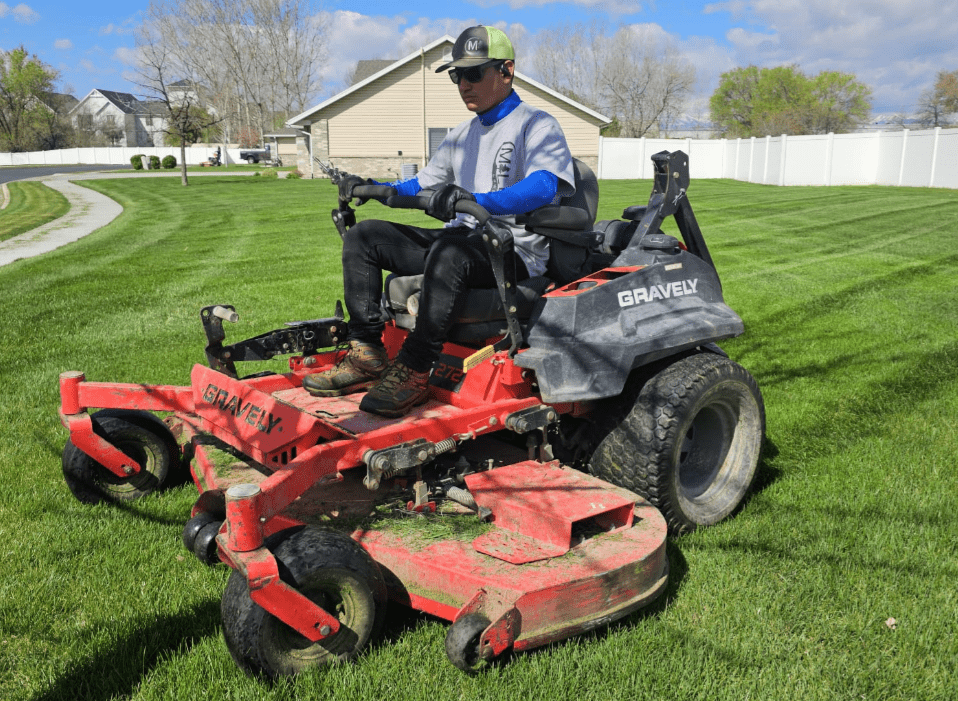Summer is the perfect time to enjoy your lawn, but it’s also the season when weeds can become a major problem. Weeds not only detract from the beauty of your lawn but also compete with your grass for nutrients, water, and sunlight. To help you maintain a lush, green lawn all summer long, Saratoga Mowing has compiled this comprehensive guide on weed prevention in Orem, Utah.
Understanding Common Weeds in Orem, Utah
Before diving into weed prevention strategies, it’s essential to understand the common types of weeds found in Orem. These include:
- Dandelions: Known for their bright yellow flowers, dandelions are perennial weeds that can quickly spread across your lawn.
- Crabgrass: This annual weed thrives in the summer heat and can take over thin or bare patches of your lawn.
- Bindweed: A persistent perennial, bindweed has deep roots and can be challenging to eradicate.
- Clover: While some homeowners appreciate clover for its nitrogen-fixing properties, others see it as an invasive weed.
Importance of Weed Prevention
Weed prevention is crucial for maintaining a healthy and attractive lawn. Weeds compete with your grass for essential resources, leading to weakened turf and increased susceptibility to pests and diseases. By implementing effective weed control strategies, you can ensure your lawn remains vibrant and resilient.
Pre-Emergent Herbicides: Your First Line of Defense
One of the most effective ways to prevent weeds is by using pre-emergent herbicides. These products work by creating a barrier in the soil that prevents weed seeds from germinating.
- Timing is Key: Apply pre-emergent herbicides in early spring before weed seeds begin to germinate. In Orem, this typically means applying the herbicide in late March or early April.
- Follow Instructions: Always read and follow the manufacturer’s instructions for application rates and safety precautions.
Regular Lawn Maintenance: A Healthy Lawn is a Weed-Free Lawn
Maintaining a healthy lawn is one of the best ways to prevent weeds. Healthy grass can out compete weeds, making it difficult for them to establish. Here are some essential lawn maintenance practices:
Proper Mowing
- Mow High: Set your mower blades to a height of about 2.5 to 3 inches. Taller grass shades the soil, reducing the chance of weed seeds germinating.
- Mow Regularly: Regular mowing prevents weeds from flowering and spreading seeds. Aim to mow your lawn once a week during the growing season.
Adequate Watering
- Water Deeply: Water your lawn deeply but infrequently to encourage deep root growth. This helps your grass become more drought-tolerant and better able to compete with weeds.
- Water Early: Water your lawn in the early morning to minimize evaporation and reduce the risk of fungal diseases.
Fertilization
- Balanced Fertilizer: Use a balanced fertilizer to provide your lawn with the essential nutrients it needs to stay healthy. Apply fertilizer in early spring and late fall for best results.
- Soil Testing: Conduct a soil test to determine your lawn’s specific nutrient needs and adjust your fertilization plan accordingly.
Mechanical Weed Control: Tackling Weeds by Hand
For smaller weed infestations, hand-pulling can be an effective method of control. Here are some tips for successful hand-pulling:
- Remove the Roots: Ensure you remove the entire root system to prevent regrowth. This is especially important for perennial weeds like dandelions and bindweed.
- Pull After Rain: Weeds are easier to pull when the soil is moist, so try to pull weeds after a rainstorm or after watering your lawn.
Mulching: Smothering Weeds Before They Start
Mulching is another effective way to prevent weeds. By covering the soil with a layer of mulch, you can block sunlight and prevent weed seeds from germinating.
- Organic Mulch: Use organic mulch such as wood chips, straw, or grass clippings. These materials decompose over time, adding nutrients to the soil.
- Mulch Depth: Apply a 2-3 inch layer of mulch around plants and flower beds to effectively smother weeds.
Post-Emergent Herbicides: Targeting Established Weeds
If weeds have already taken hold in your lawn, post-emergent herbicides can help. These herbicides are designed to kill weeds that are actively growing.
- Selective Herbicides: Use selective herbicides that target specific types of weeds without harming your grass. This is particularly useful for broadleaf weeds like dandelions and clover.
- Spot Treatment: Apply post-emergent herbicides as a spot treatment to avoid damaging your lawn. Follow the product instructions carefully to ensure effective weed control.
Long-Term Weed Prevention Strategies
For lasting weed control, consider implementing these long-term strategies:
- Overseeding: Overseed your lawn in the fall to fill in bare or thin spots. This helps prevent weeds from establishing in these areas.
- Aeration: Aerate your lawn annually to reduce soil compaction and improve water and nutrient absorption. This promotes healthy grass growth and discourages weeds.
- Integrated Pest Management (IPM): Implement an IPM approach that combines cultural, mechanical, and chemical control methods for effective and sustainable weed management.
A Beautiful, Weed-Free Lawn in Orem, Utah
Maintaining a weed-free lawn in Orem, Utah, requires a combination of preventive measures, regular maintenance, and targeted treatments. By following the strategies outlined in this guide, you can conquer weeds and enjoy a lush, green lawn all summer long. For professional assistance with weed prevention and lawn care, contact Saratoga Mowing today.
By implementing these weed prevention strategies, you can ensure your lawn remains beautiful and healthy throughout the summer. Remember, a proactive approach is the key to successful weed management. For more information or to schedule a consultation, visit Saratoga Mowing.


